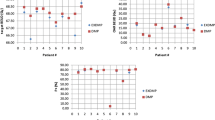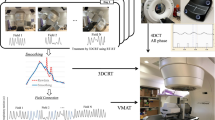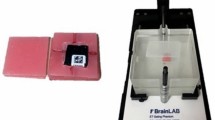Abstract
The purpose of the study is to evaluate the accuracy of two deformable image registration algorithms by examining their influence on the dose summation results obtained using 4DCT (four dimensional computed tomography) dose distributions based on ‘4D’ planned and ‘4D optimal’ IMRT (intensity modulated radiation therapy) plans. For ten lung cancer patients, 4D step and shoot IMRT plans were produced. The breathing cycle was divided into ten parts and for each part a set of CT images was acquired. For each patient the treatment plan was copied to the CTs of each phase and subsequently recalculated. Each phase CT was then registered to the average intensity projection (AIP) CT using a deformable image registration (DIR) algorithm and the composite dose distribution was then calculated by summing up the deformed dose distributions from all the phases (‘4D’ treatment plan). The ‘4D optimal’ treatment plan was created by producing an optimal plan on the CTs of each phase of the respiratory cycle and summing up the deformed dose distributions from all the phases. The results indicate that it is possible to map the dose distributions of different breathing phases in lung using DIR, and that different DIR methods and target characteristics (motion amplitude, size, location) affect the differences between original plan, ‘4D’ and ‘4D optimal’ dose distributions. Although the ‘4D optimal’ plans were designed to achieve 95% target coverage, both of the used DIR methods failed to translate that coverage in some instances. The same variation between these methods was also observed in the ‘4D’ plan comparison. This study shows that it is feasible to perform an acceptably accurate calculation of the composite deformed dose. However, it is important to account for tumor motion and body deformation especially when the tumor volume is small and/or located in the lower lobe of the lung.






Similar content being viewed by others
References
Xu H, Gong G, Wei H, Chen L, Chen J, Lu J, Liu T, Zhu J, Yin Y (2014) Feasibility and potential benefits of defining the internal gross tumor volume of hepatocellular carcinoma using contrast-enhanced 4D CT images obtained by deformable registration. Radiat Oncol 9:221
Yip C, Thomas C, Michaelidou A, James D, Lynn R, Lei M, Guerrero Urbano T (2014) Co-registration of cone beam CT and planning CT in head and neck IMRT dose estimation: a feasible adaptive radiotherapy strategy. Br J Radiol 87:20130532
Kessler M-L (2006) Image registration and data fusion in radiation therapy. Br J Radiol 79:S99–S108
Kadoya N, Fujita Y, Katsuta Y, Dobashi S, Takeda K, Kishi K, Kubozono M, Umezawa R, Sugawara T, Matsushita H, Jingu K (2014) Evaluation of various deformable image registration algorithms for thoracic images. J Radiat Res 55:175–182
Oh S, Kim S (2017) Deformable image registration in radiation therapy. Radiat Oncol J 35(2):101–111
Valdes G, Lee C, Tenn S, Lee P, Robinson C, Iwamoto K, Low D, Lamb JM (2017) The relative accuracy of 4D dose accumulation for lung radiotherapy using rigid dose projection versus dose recalculation on every breathing phase. Med Phys 44(3):1120–1127
Tian Y, Wang Z, Ge H, Zhang T, Cai J, Kelsey C, Yoo D, Yin FF (2012) Dosimetric comparison of treatment plans based on free breathing, maximum, and average intensity projection CTs for lung cancer SBRT. Med Phys 39(5):2754–2760
Brock K, Mutic S, McNutt TR, Li H, Kessler ML (2017) Use of image registration and fusion algorithms and techniques in radiotherapy: Report of the AAPM Radiation Therapy Committee Task Group No. 132. Med Phys 44(7):e43–e76
Latifi K, Zhang G, Stawicki M, van Elmpt W, Dekker A, Forster K (2013) Validation of three deformable image registration algorithms for the thorax. J Appl Clin Med Phys 14(1):3834
Yeo UJ, Taylor ML, Supple JR, Smith RL, Dunn L, Kron T, Franich RD (2012) Is it sensible to “deform” dose? 3D experimental validation of dose-warping. Med Phys 39(8):5065–5072
Yeo UJ, Supple JR, Taylor ML, Smith R, Kron T, Franich RD (2013) Performance of 12 DIR algorithms in low-contrast regions for mass and density conserving deformation. Med Phys 40(10):101701
Hardcastle N, Bender ET, Tomé WA (2014) The effect on dose accumulation accuracy of inverse-consistency and transitivity error reduced deformation maps. Australas Phys Eng Sci Med 37(2):321–326
Velocity AI. Velocity Medical Solutions. http://www.velocitymedical.com
Chen Y, Ye X (2010) Inverse consistent deformable image registration. In: Alladi K, Klauder JR, Rao CR (eds) The legacy of Alladi Ramakrishnan in the mathematical sciences. Springer, New York, pp 419–440
Starkschall G, Desai N, Balter P, Prado K, Luo D, Cody D, Pan T (2007) Quantitative assessment of four-dimensional computed tomography image acquisition quality. J Appl Clin Med Phys 8(3):2362
Buzdar SA, Rao MA, Nazir A (2009) An analysis of depth dose characteristics of photon in water. J Ayub Med Coll Abbottabad 21(4):41–45
Oliver M, Chen J, Wong E, Van Dyk J, Perera F (2007) A treatment planning study comparing whole breast radiation therapy against conformal, IMRT and tomotherapy for accelerated partial breast irradiation. Radiother Oncol 82(3):317–323
Stanley N, Glide-Hurst C, Kim J, Adams J, Li S, Wen N, Chetty IJ, Zhong H (2013) Using patient-specific phantoms to evaluate deformable image registration algorithms for adaptive radiation therapy. J Appl Clin Med Phys 14(6):4363
Kadoya N, Fujita Y, Katsuta Y, Dobashi S, Takeda K, Kishi K, Kubozono M, Umezawa R, Sugawara T, Matsushita H, Jingu K (2014) Evaluation of various deformable image registration algorithms for thoracic images. J Radiat Res 55(1):175–182
Author information
Authors and Affiliations
Corresponding author
Ethics declarations
Conflict of interest
The authors declare that there is no conflict of interest regarding the publication of this paper.
Ethical approval
All procedures performed in studies involving human participants were in accordance with the ethical standards of the Medical University of Warsaw and with the 1964 Helsinki declaration and its later amendments or comparable ethical standards.
Informed consent
Informed consent was obtained from all individual participants.
Rights and permissions
About this article
Cite this article
Jurkovic, IA., Stathakis, S., Li, Y. et al. Use of lung treatment plans to evaluate DIR algorithms. Australas Phys Eng Sci Med 41, 837–845 (2018). https://doi.org/10.1007/s13246-018-0677-0
Received:
Accepted:
Published:
Issue Date:
DOI: https://doi.org/10.1007/s13246-018-0677-0




